As one of the operators increased the capacity of 3G in the densely populated area of Minsk, not forgetting the upcoming LTE
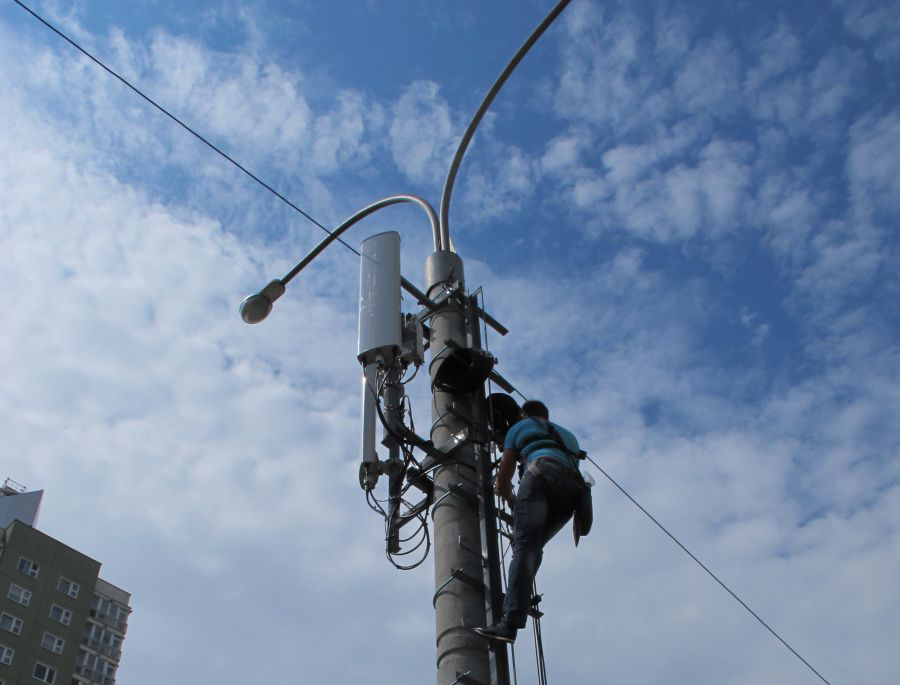
It turned out that not far from my monastery they began to establish a base station. As a person close to telecommunications, I could not ignore this event.
Under the cut, the time-consuming process of installing a modular base station of type SingleRAN in the most densely populated area of the city of Kamennaya Gorka is described, the contents of the operator boxes on the lighting poles are described and the purpose of the devices installed in them is described.
We omit the stage of office planning (it is worthy of a separate post, given our reality) and move to the place of events. Since the area has a very high density of buildings, the buildings are mostly high-rise and belong to the housing stock, radio relay lines (RRL) are practically never used, and transport to stations is provided by fiber-optic communication lines (FOCL). Fortunately, optics for home Internet have already been installed in the basements of neighboring buildings, so there are cable wells and lines in which you can lay the necessary communications, although you had to dig and drill a lot.
The fact is that for the placement of equipment, a non-standard configuration was developed, associated with the need to cover a large micro-district. Three sectors of the same station, located 130 meters from each other, were installed spaced into three supports.
In order not to disturb pedestrians and dig paths, two drills were involved.
When the drilling team finishes work, cable men and installers come in.
First, on each of the three supports, a harness for mounting the antennas is mounted and on one of them an antivadal box to accommodate the (e) NodeB itself. It is worth noting that the appearance of the support had to be approved in Mingorsvet - such requirements in Belarus. In general, with base stations in terms of monitoring compliance with various state standards strictly - before installation, the station's power and frequency characteristics are authorized by the BelGIE Telecommunication Control Inspection. And after installation, both the representatives of the network development group and the inspectors leave for the place to make sure that all the norms are met and that the station meets its design specifications.
The photo shows the preparatory work for the installation of RFS antennas, one of the oldest manufacturers of equipment for telecommunication networks, which is in no way inferior to or even superior in some respects to Kathrein, Erricsson, Allgon and others.
Antennas are designed to receive and transmit a signal in the range 1710-2200MHz.
On all three supports, there is such an azimuthal configuration - the antennas “shine” into the spaces between houses that are perpendicular to the road.

Schematically show the connection of antennas, radio modules RRU to the baseband processing unit BBU (baseband unit) as follows.

Naturally, the power cable is also suitable for the RRU - after all, it is an active software and hardware system, which is precisely the basis of the SingleRAN (radio access network) philosophy - one radio module can support different mobile network standards.
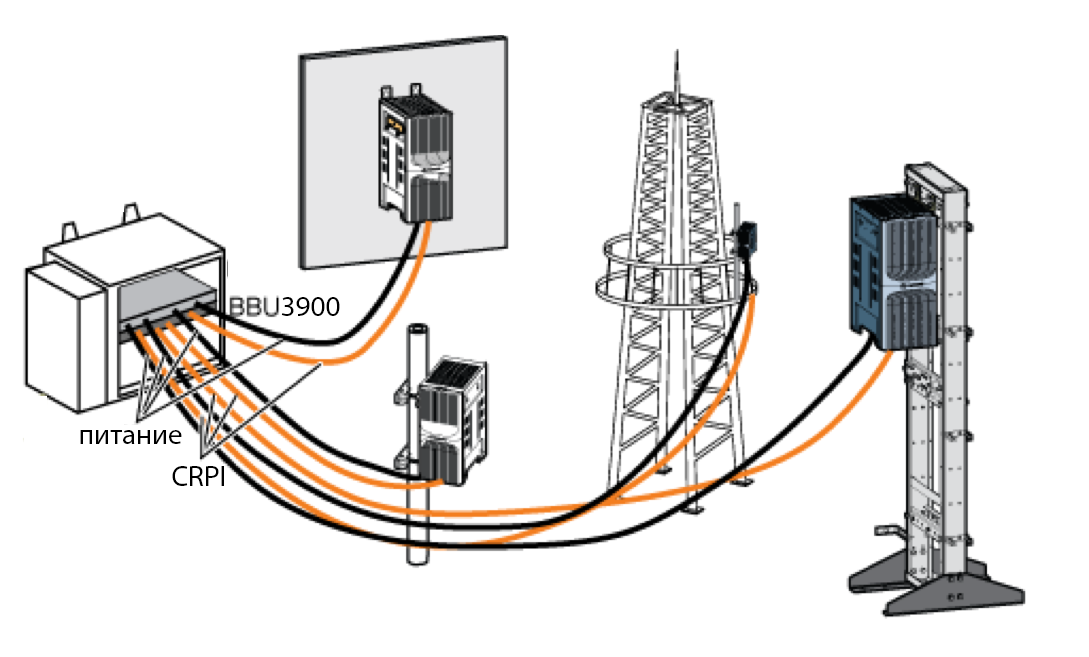
The placement of radio modules directly at the antennas outside the telecommunication cabinet is a fairly new solution, due to the fact that the feeders are expensive, quite sensitive to mechanical damage, which creates additional difficulties during installation, maintenance and replacement in case of damage. It should also be remembered that theft of these feeders and grounding cables often occurs, because they contain copper, so beloved by frequent visitors of non-ferrous metals reception centers.
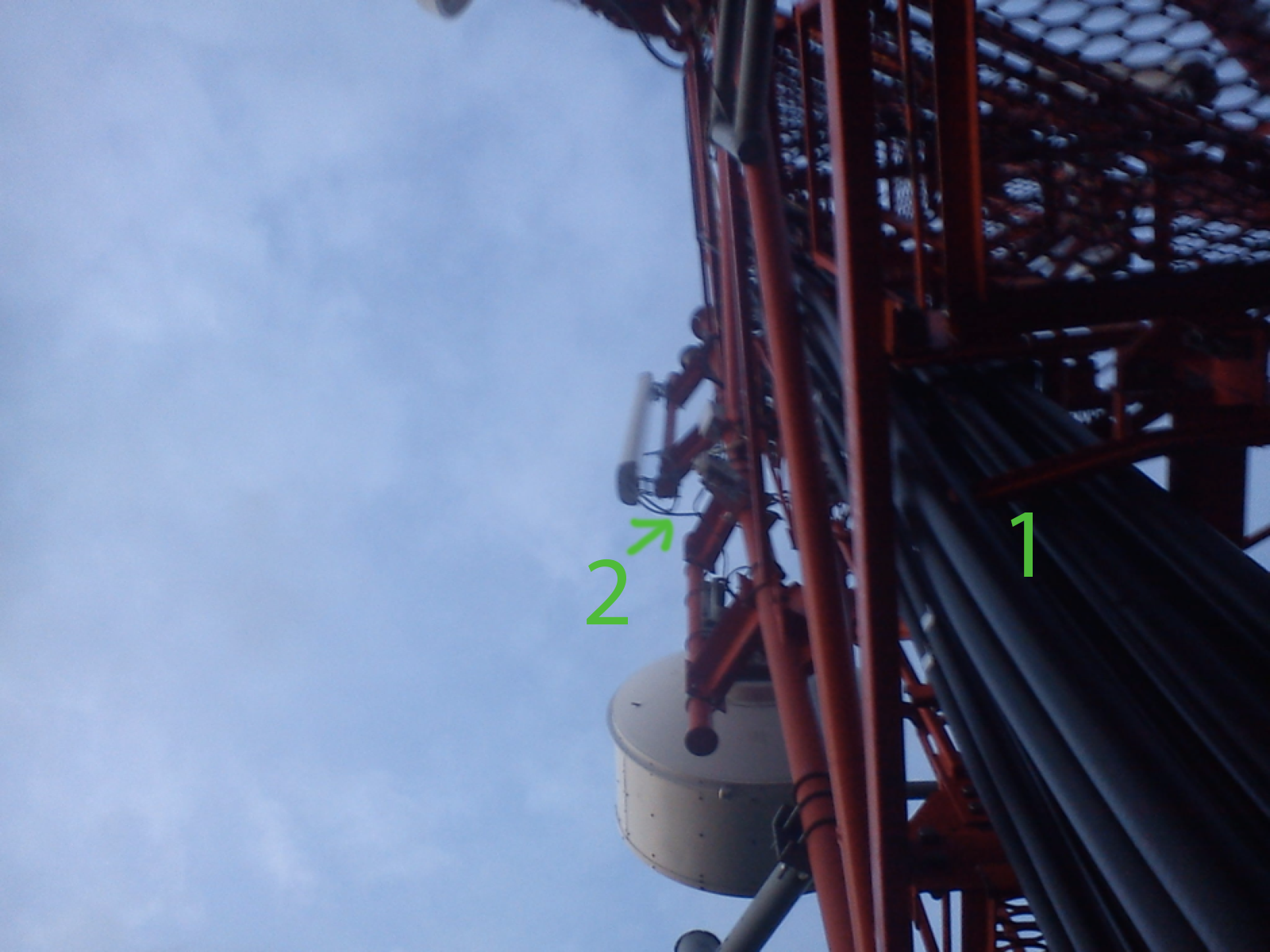
Such radio frequency feeders [1] used to be connected to antennas, however, thinner jump cables were also used for antennas [2].
A bit about feeders and jumpers
From Wikipedia:
Fyder (English feeder from feed - to feed) - an electric circuit (transmission line) and auxiliary devices by which the energy of the radio frequency signal is supplied from the radio transmitter to the antenna or from the antenna to the radio.
There are open and closed feeders. Shielded lines (such as coaxial cable) are classified as closed feeders. Open - unshielded wire lines, dielectric waveguides, lens and mirror quasi-optical lines.
Jumper in radio paths - a cable that usually terminates the feeders on the last few meters of the feeder. It is he who connects to the antennas.
The use of the jumper is due to the fact that the feeders themselves have a sufficiently large diameter (5/4 'or 7/8') and as a result there are difficulties in bending when connected to antennas, the jumper, in turn, has a diameter of 1/2 'or 3 /8'.
Fyder (English feeder from feed - to feed) - an electric circuit (transmission line) and auxiliary devices by which the energy of the radio frequency signal is supplied from the radio transmitter to the antenna or from the antenna to the radio.
There are open and closed feeders. Shielded lines (such as coaxial cable) are classified as closed feeders. Open - unshielded wire lines, dielectric waveguides, lens and mirror quasi-optical lines.
Jumper in radio paths - a cable that usually terminates the feeders on the last few meters of the feeder. It is he who connects to the antennas.
The use of the jumper is due to the fact that the feeders themselves have a sufficiently large diameter (5/4 'or 7/8') and as a result there are difficulties in bending when connected to antennas, the jumper, in turn, has a diameter of 1/2 'or 3 /8'.
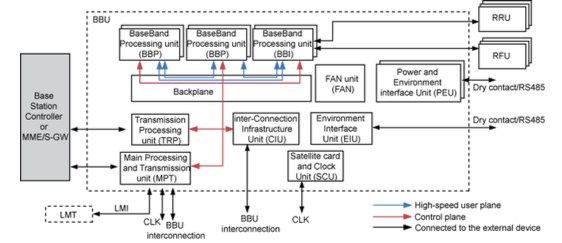
Scheme of interconnection of modules in a given BS. A single chassis and many modules for a variety of needs - this is almost an international standard.
This is, in fact, the RRU module, which converts the signal from the BBU to a radio frequency signal, followed by amplification for broadcasting, and also performs the inverse transformation of the signal received by the antennas from subscriber units.
In the all-weather compartment, RRU - connectors for connecting 48 V DC power and two optical CPRI (Common Public Radio Interface) - cables through which digital data (both service and signal) is exchanged with BBU. One cable is connected to the base frequency processing module, the second connector in the radio module is used for cascading up to three RRUs. This is necessary for the most multi-tasking division of the cell into sectors.
CPRI is a fairly new interface, supported by all the giant manufacturers of equipment for cellular communications. For example, this standard allows you to connect remote up to 40 kilometers of radio modules.
Let's go higher.
Few people notice small antennas at base stations that only one radio interface fits into. The arrow in the photo is the GPS receiver, it is needed to receive accurate time signals. In CDMA standards, the use of GPS for synchronization between BSs reduces the cost of frequency calibrations. Accurate satellite time allows you to achieve a smoother handover on the network, and in LTE and LTE Advanced GPS it is a vital component for processing TDD (time-division duplex), i.e. synchronously switching the signal processing unit to the reception / transmission modes.

It looks like this, by the way, it is easy to confuse it from the ground with the light-shielding lamp of a high-rise object.

So, from top to bottom the contents of a typical DBS3900 BS: air cooling and ventilation system [1], power supply module [2], BBU [3], and at the very bottom - HAU [4] (heat assembly unit), in Russian “heater” . Always remember our winters.
DBS3900 is a good operator solution that supports a smooth transition to LTE eNodeB networks using the SingleRAN strategy - with the simultaneous provision of GSM, UMTS, LTE services in various variations.
Now about each module in turn.
The power module is the largest in the rack, consists of several subrack-s:
PMU [1], AC / DC PSU [2] (rectifiers), EPU [3]. PMU - control unit for energy supply, power distribution and signaling of external accidents (smoke sensor, tamper sensors, temperature sensor, etc.). It communicates with the main module via the RS 232 or RS 422 interface, controls the charging and discharging of backup batteries. PSU converts 220V AC to -48V DC, monitors the status and status of the batteries (battery). EPU - module for connecting to an external power source and its wiring for all modules. On it are protective devices that protect the equipment from failures in the mains and batteries.
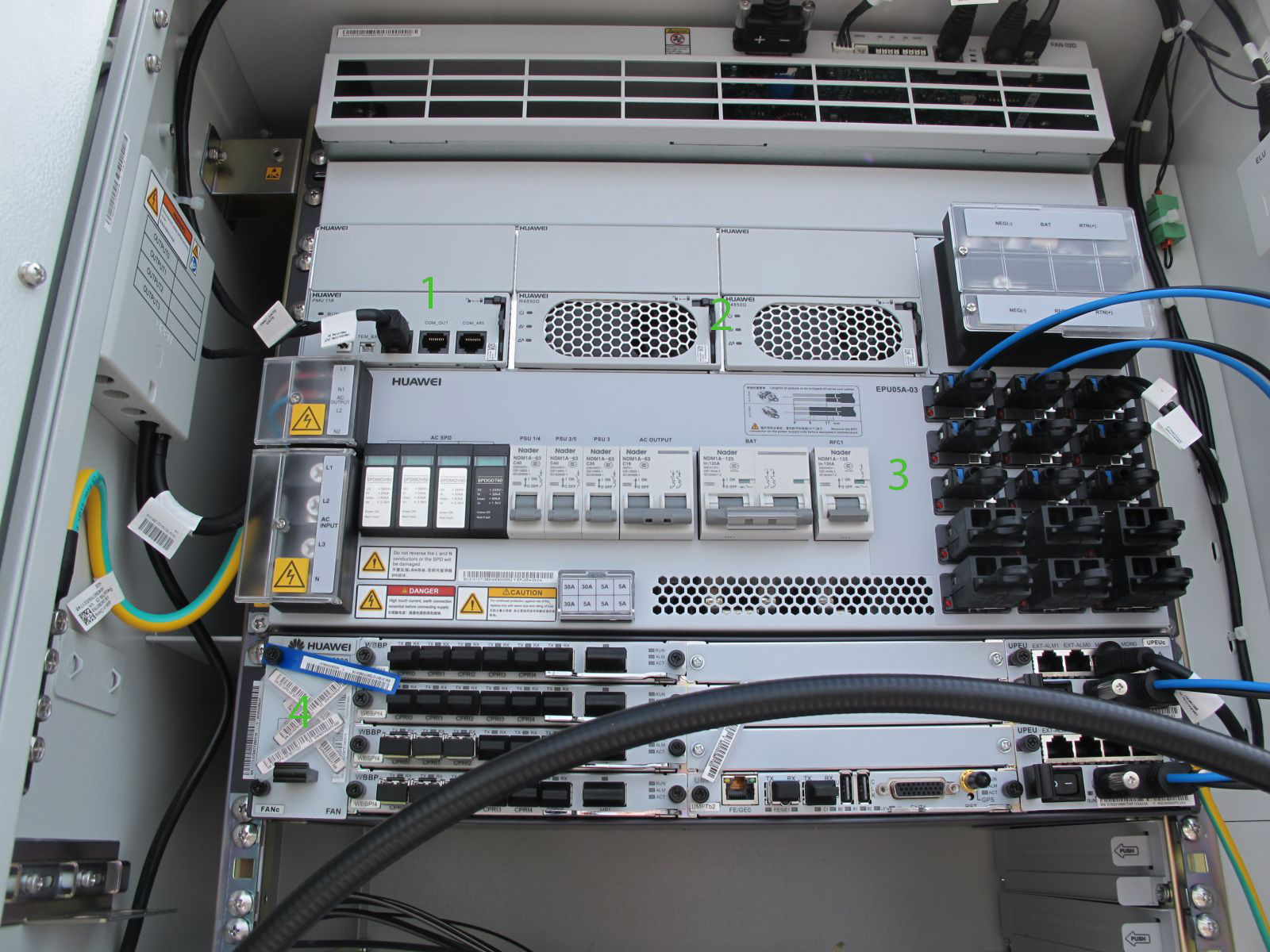
BBU [4] - associates a BS with a BSC or RNC (if used on a 3G network). It performs the control functions of the distribution of BS resources, such as frequencies, channels, bandwidth, as well as communication lines of the BS with the outside world, provides reference synchronization - exact time. Specifically, this base station was installed with a multimode UMPT module (universal main processing and transmission unit) to support UMTS, and in the future, LTE.

UMPT - universal main processing and transmission unit, the main BBU module - it contains all the necessary data for the station to work - tuning can be done either remotely, either through the console port or USB. This unit processes signaling in GSM and UMTS networks, E-UTRAN in LTE, optics are also installed on it for traffic exchange with the transport network (usually from 100 Mbps to 1 GBit / s), there is also a port for GPS synchronization . To expand the capacity of the BS there is an optical CI port for communication with the second BBU. During operation, if necessary, the capacity of the data exchange channel with the BS can be increased by adding additional transport modules UTRP (universal transmission processing unit), each of which can provide an additional 2 gigabits of communication channel with the operator network.
WBBP - WCDMA baseband processing unit, communication module with RRU radio modules. As many have already guessed, to support the BBU standard UMTS. Each radio module provides a total speed of exchange with subscribers - 512 Mbit outgoing and 768 Mbit downstream and is limited to 384 connections with user terminals. At the moment, this type of station can provide simultaneous communication with approximately 1,500 devices.
For final LTE input, it will be enough to install another LBBP board or a second BBU module with them, drop the firmware and everything will be ready!
And this is how one of the similarly equipped BBUs looks at another facility - in the world-famous Minsk Arena after the 2014 world hockey championship. Two base frequency processing modules are used to simultaneously serve a larger number of subscribers inside the arena.
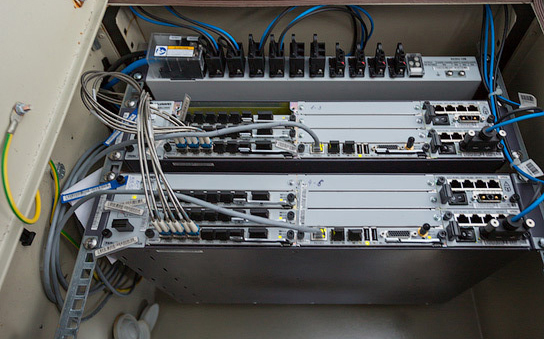
Described in the post BS after full installation and commissioning.

The box on the left is battery-powered, for backup power supply of equipment in case of problems in the city network.
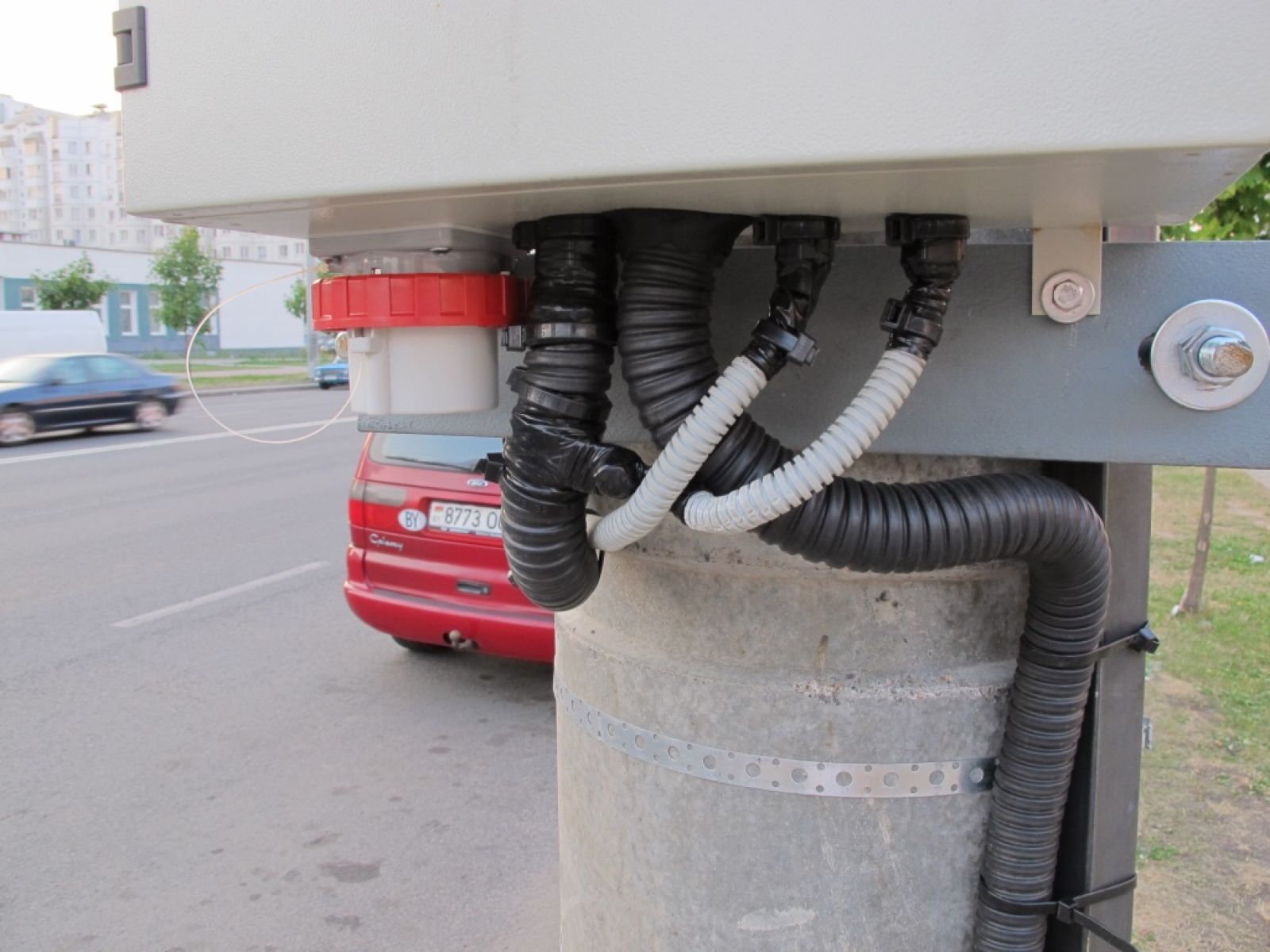
With a long absence of electricity, batteries are provided for charging from a three-phase gas generator. Yes, in Belarus you can just come and leave the buzzing generator on the street unattended, however, you couldn’t do without cases when especially enterprising citizens quietly took away this device (so needed in personal households) in an unknown direction.

The neighboring sector, working in a triad with BTS3900 cabinet equipment in the previous photos.
So, using a specific example, I tried to show how operators use two mods of iron to kill two birds with one stone - they increase the capacity of the existing network and take care of the introduction of LTE, and, hopefully, without losing the services of the previous generation.
